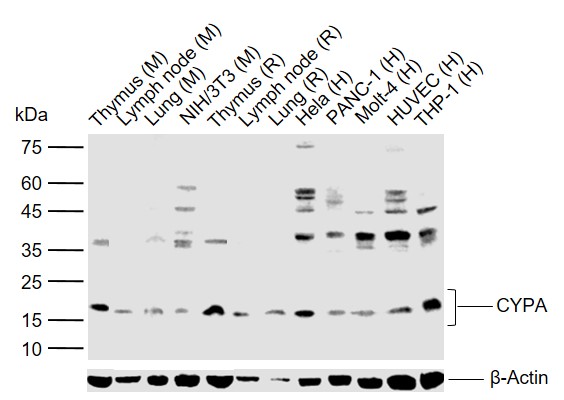Cyclophilin A antibody [C1C3]
GTX104698
ApplicationsImmunoFluorescence, Western Blot, ImmunoCytoChemistry, ImmunoHistoChemistry, ImmunoHistoChemistry Paraffin
Product group Antibodies
ReactivityHamster, Human, Mouse, Rat
TargetPPIA
Overview
- SupplierGeneTex
- Product NameCyclophilin A antibody [C1C3]
- Delivery Days Customer9
- Application Supplier NoteWB: 1:5000-1:20000. ICC/IF: 1:100-1:1000. IHC-P: 1:100-1:1000. *Optimal dilutions/concentrations should be determined by the researcher.Not tested in other applications.
- ApplicationsImmunoFluorescence, Western Blot, ImmunoCytoChemistry, ImmunoHistoChemistry, ImmunoHistoChemistry Paraffin
- CertificationResearch Use Only
- ClonalityPolyclonal
- Concentration1 mg/ml
- ConjugateUnconjugated
- Gene ID5478
- Target namePPIA
- Target descriptionpeptidylprolyl isomerase A
- Target synonymsCYPA, CYPH, HEL-S-69p, peptidyl-prolyl cis-trans isomerase A, PPIase A, T cell cyclophilin, cyclosporin A-binding protein, epididymis secretory sperm binding protein Li 69p, peptidylprolyl isomerase A (cyclophilin A), rotamase A
- HostRabbit
- IsotypeIgG
- Protein IDP62937
- Protein NamePeptidyl-prolyl cis-trans isomerase A
- Scientific DescriptionThis gene encodes a member of the peptidyl-prolyl cis-trans isomerase (PPIase) family. PPIases catalyze the cis-trans isomerization of proline imidic peptide bonds in oligopeptides and accelerate the folding of proteins. The encoded protein is a cyclosporin binding-protein and may play a role in cyclosporin A-mediated immunosuppression. The protein can also interact with several HIV proteins, including p55 gag, Vpr, and capsid protein, and has been shown to be necessary for the formation of infectious HIV virions. Multiple pseudogenes that map to different chromosomes have been reported. [provided by RefSeq]
- ReactivityHamster, Human, Mouse, Rat
- Storage Instruction-20°C or -80°C,2°C to 8°C
- UNSPSC12352203
References
- Conte M, Palumbo R, Monti A, et al. Relevance of AIF/CypA Lethal Pathway in SH-SY5Y Cells Treated with Staurosporine. Int J Mol Sci. 2021,23(1). doi: 10.3390/ijms23010265Read this paper
- Shih HJ, Chang HF, Chen CL, et al. Differential expression of hypoxia-inducible factors related to the invasiveness of epithelial ovarian cancer. Sci Rep. 2021,11(1):22925. doi: 10.1038/s41598-021-02400-1Read this paper
- Shih HJ, Chen CL, Torng PL. IGFBP3 inhibits angiogenesis through intracellular regulation of THBS1 expression. Am J Cancer Res. 2020,10(6):1728-1744.Read this paper
- Chen JF, Tsai YT, Lai YH, et al. Proteomic analysis of Antrodia Cinnamomea-induced ER stress in liver cancer cells. J Pharm Biomed Anal. 2020,187:113142. doi: 10.1016/j.jpba.2020.113142Read this paper
- Rosales Ramirez R, Ludert JE. The Dengue Virus Nonstructural Protein 1 (NS1) Is Secreted from Mosquito Cells in Association with the Intracellular Cholesterol Transporter Chaperone Caveolin Complex. J Virol. 2019,93(4). doi: 10.1128/JVI.01985-18Read this paper
- Lin CY, Chang TW, Hsieh WH, et al. Simultaneous induction of apoptosis and necroptosis by Tanshinone IIA in human hepatocellular carcinoma HepG2 cells. Cell Death Discov. 2016,2:16065.Read this paper
- Huang HJ, Lin CC, Chou HC, et al. Proteomic analysis of rhein-induced cyt: ER stress mediates cell death in breast cancer cells. Mol Biosyst. 2014,10(12):3086-100. doi: 10.1039/c4mb00451eRead this paper
- May EW, Lin ST, Lin CC, et al. Identification of up- and down-regulated proteins in doxorubicin-resistant uterine cancer cells: reticulocalbin-1 plays a key role in the development of doxorubicin-associated resistance. Pharmacol Res. 2014,90:1-17. doi: 10.1016/j.phrs.2014.08.007Read this paper
- Fan CY, Chou HC, Lo YW, et al. Proteomic and redox-proteomic study on the role of glutathione reductase in human lung cancer cells. Electrophoresis. 2013,34(24):3305-14. doi: 10.1002/elps.201300250Read this paper






